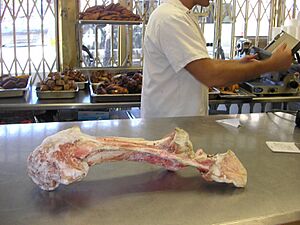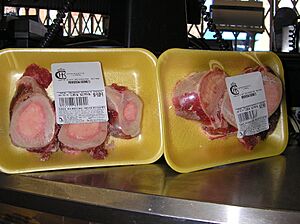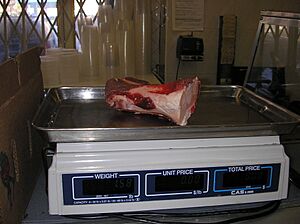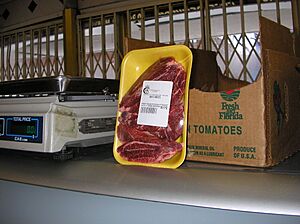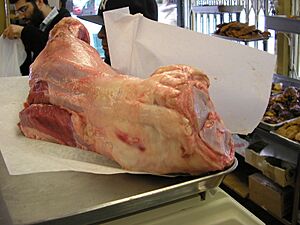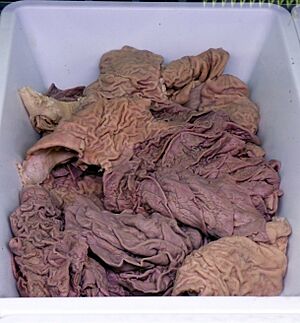Foreleg, cheeks and maw facts for kids
| Halakhic texts relating to this article | |
|---|---|
| Torah: | Deuteronomy 18:3 |
| Mishnah: | Chullin 10:1 |
| Babylonian Talmud: | Bekhorot 27a |
The foreleg, cheeks, and maw (stomach) are special parts of an animal that has been slaughtered according to Jewish law (kosher). Giving these parts to a kohen (a Jewish priest) is a positive commandment from the Hebrew Bible. After an animal is slaughtered by a shochet (kosher slaughterer), the shochet must separate these specific cuts. He then gives them to a kohen for free. The kohen does not pay or do any service for them.
Contents
What the Bible Says
The idea of giving these gifts to the priest comes from the book of Deuteronomy in the Bible. It says:
And this shall be the priests' due from the people, from them that offer a sacrifice, whether it be ox or sheep, that they shall give unto the priest the shoulder, and the two cheeks, and the maw.
This means that when people offer an animal, certain parts belong to the priests.
Does This Apply Everywhere?
Ancient Jewish Views
Ancient Jewish texts like the Mishnah, Talmud, and Sifre teach that this commandment applies both in the Land of Israel and in other countries. They say it's a personal duty, not just a rule for the land itself. The Talmud even mentions punishments for people or communities who didn't give these gifts.
Important Rabbis' Opinions
Many important Jewish scholars throughout history agreed that giving these gifts is a must.
- Hai Gaon (an early scholar) believed that people who didn't give the gifts should be excommunicated (removed from the community).
- Maimonides, a very famous Jewish thinker, also said it was completely required outside Israel. He believed not giving them could lead to excommunication.
- Nachmanides thought that if people became too relaxed about this rule outside Israel, they might forget it entirely. So, he said the gifts must always be given.
- Other scholars like The Raavad and The Mordechai also strongly supported giving these gifts in all places.
- The Vilna Gaon, another respected rabbi, also seemed to agree that these gifts are required by Jewish law. His students even said he actively gave them.
Rashi's Different View
Rashi, a very influential French rabbi, once wrote a letter trying to explain why some people didn't give these gifts. He mentioned an older opinion that a similar commandment (giving the first shearing of sheep's wool) didn't apply outside Israel. Rashi then suggested that the same idea might apply to the foreleg, cheeks, and maw. He noticed that in his area, people often didn't give these gifts. Rashi said that rabbis shouldn't teach this leniency (being less strict) to everyone. But if people were already doing it, a rabbi didn't need to object. He also noted that sometimes there were no Kohanim around, making it impossible to give the gifts. Still, Rashi praised those who made the effort to give them.
However, some experts later found that parts of Rashi's writings on this topic might have been added by others. They believe these additions might not fully show Rashi's true support for giving the gifts.
Practice in Yemen
For a long time, Jewish communities in Yemen followed the custom of giving these gifts. A leading Yemenite rabbi, Yachya Tzalach, wrote in the 19th century that this was an ancient and important tradition in their community.
Details of the Mitzvah
Whether one person slaughters an animal or a large meat operation does, the gifts must be given. Even if a Kohen owns the animal, or if a Jew and non-Jew own it together, the gifts are still required.
The "Marking" Rule
The Mishnah mentions that if a non-Jew owns the animal when it's slaughtered, the Jewish buyer needs to "mark" the gifts.
- Maimonides explained that marking helps make sure these special parts go to the Kohen. This is because a non-Kohen is not allowed to eat these specific parts.
- Rashi had a different idea. He thought the mark was a public sign. It would show everyone that the animal was owned by a non-Jew at the time of slaughter. This would prevent people from thinking the Jewish owner was breaking the rule by not giving the gifts.
Why Some Don't Give the Gifts Today
In many places outside Israel, these gifts are often not given. This is partly because the parts are valuable, and giving them away would make kosher meat more expensive.
- One common way people avoid the obligation is by having a non-Jew own the animal at the time of slaughter. The shochet might even go to the non-Jew's property to slaughter the animal. Then, the Jewish buyer purchases the meat afterward. The idea here is that since a non-Jew owned the animal during slaughter, the gift rule doesn't apply.
- Some people also point to the writings of the Tur and Shulchan Aruch, which suggest that in practice, these gifts are not always given outside Israel.
- Another reason sometimes given is that it can be hard to confirm if someone is truly a Kohen by lineage, especially since money is involved.
Arguments Against Not Giving
However, many scholars argue against these reasons for not giving the gifts:
- Some say that trying to avoid the mitzvah by having a non-Jew own the animal is a "trick" that unfairly takes away what belongs to the Kohen.
- They also argue that since most animals are found to be kosher, it's likely the animal will end up being Jew-owned, making the gift obligation apply.
- Many important rabbis, like the Mordechai, Rabbeinu Asher, and the Tashbetz, believed that their teacher, Rabbi Meir of Rothenburg, actually supported giving the gifts outside Israel, despite what some later texts claimed.
- They also point out that the main author of the Shulchan Aruch, Rabbi Yosef Karo, usually followed the opinions of the most important earlier rabbis. Many of these rabbis believed the gifts should be given outside Israel.
- Finally, the responsibility to find a Kohen rests on the giver. Modern Kohanim have a strong claim to their status, which is enough for them to receive the gifts.
Is the Meat Kosher?
Jewish law also discusses whether the meat from an animal is still "kosher" (fit to eat) if the gifts were not given. The main concern is about "Gezel" (theft).
The Special Parts (Cheek, Tongue, Foreleg)
Most rabbis agree that the actual foreleg, cheek meat, and maw can only be eaten by a Kohen. If a Kohen allows it, a non-Kohen might be able to eat them. But first, the gifts must be given to the Kohen.
The Rest of the Meat
Regarding the rest of the animal's meat (if the gifts weren't given), there are different opinions. The common view is that this meat can be eaten. However, it is considered proper and good to avoid eating it unless the gifts have been given to a Kohen.
Why This Mitzvah is Important
Doing this mitzvah is believed to bring special blessings. Some say it can help a person gain Ruach HaKodesh (divine inspiration). It is also believed to bring strength and help to the Jewish people against their enemies.
The Talmud tells a story to show the importance of this mitzvah:
"Rabbi, Rabbi! The Zoroastrians have come to power in Babylonia!" Rabbi Yochanan gasped and fell from his chair – just the thought of his fellow Jews in the Diaspora submitting to the strange decrees of the worshippers of Ahura Mazda left him in total shock. "Be at ease, dear leader," his students comforted him, "they can be bought off with money." Rabbi Yochanan, getting back onto his chair listened as his pupils briefed him on the particular decree the Zoroastrians put forth. "They refuse to let us Kosher-slaughter our animals." The Rabbi heard them out, and – in his famously curt manner – stated the spiritual cause of this seemingly ridiculous law: "It's because of the gifts."
—Tractate Yevamot 63b
This story suggests that not giving the gifts could lead to difficulties for the Jewish community.
Modern Practice
In Israel
In Israel, many Jewish-owned slaughterhouses have agreements with groups of Kohanim. Instead of giving the actual meat parts, they often give money. However, some early rabbis did not approve of giving money instead of the actual gifts.
Outside Israel
Today, most Jews outside Israel, even very religious ones, are not aware of this mitzvah at all.
- One reason might be that Kohanim are not supposed to ask for the gifts. They are meant to be given willingly. So, it's assumed that Kohanim might quietly forgive the gifts.
- Another reason is that if a Jewish person is married to a Kohen's daughter, they are exempt from giving the gifts. This might make others think the gifts are not required for anyone.
When rabbis today are asked about why this mitzvah isn't practiced, they often say it's because a non-Jew owns the animal at the time of slaughter. However, those who support giving the gifts argue that this ownership status shouldn't matter if the meat is for Jewish consumers. There are efforts today to bring back the practice of giving these gifts.
The Pious View
Some very religious Jews (like certain Chassidim) choose to follow the stricter approach. They make sure to give the gifts. They also avoid eating meat from an animal if the gifts were not given. This view has been supported by famous rabbis like Rabbi Yonason Eibeshitz and the Chasam Sofer.
Value of the Gifts Today
The parts of an adult cow that are considered gifts have a certain value. Here's an estimate:
- About 0.5 pounds of cheek meat: around $14.99 per pound.
- About 1.5 pounds of fresh tongue: around $9.99 per pound.
- About 10 pounds of marrow bones (and stew meat) from the foreleg: around $5.99 per pound.
- The abomasum (maw): value not usually listed.
The total value for one cow is roughly $82.47. If you multiply this by the number of kosher cattle slaughtered daily (around 750 in the US) and the days in a year, the total yearly value of this Mitzvah in the United States is estimated to be over $22 million.


